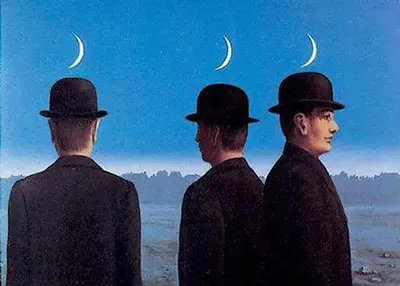The Mysteries of the Horizon, or Les Mystères de l'Horizon, also called The Masterpiece or Le Chef d'Oeuvre, is an oil on canvas work painted by René Magritte in 1955.
As is often the case with this Belgian surrealist, As is often the case with this Belgian surrealist, he challenges concepts and assumptions, and everyday objects cannot always be taken at face value.
The viewer is presented with three apparently identical men wearing bowler hats and with clearly defined outfits, placed outdoors in a dusk of indigo and black. Each upright figure has his own crescent moon hanging over him, and they all face different ways.
One looks towards the white glow of the horizon, while the second shows a little of his face as he turns towards the left hand distance, and the third is seen in profile.
The initial impression may be that they are sharing the same space, but they could also be inhabiting separate worlds, although it is impossible for the eye to discern where one person's sky becomes another's.
The figures present no personalities - they could all be the same or have none at all. It is the suggestion of being both part of the same world, and yet also apart from it, that makes it vaguely disquieting and connects it with preoccupations of alienation, loneliness and isolation today.
For similar reasons, it found popularity in the sixties in the pop art movement, and was used on several album covers.
Stiff bowler-hatted gents occur throughout Magritte's work, with the first being The Musings of a Solitary Walker in 1926. They have the effect of showing personalities that cannot be identified or made individual, and so appear to be identical.
This idea is carried over to his other paintings, such as The Lovers or Les Amants. Here, an emotional kiss between two people is subverted by covering each face in cloth, thus challenging the viewer's expectations and perhaps causing them to feel slightly disturbed.
His late painting The Son of Man shows yet another smart man in a bowler hat, this time with a green apple hiding his face. It was a common theme throughout the surrealist movement, which used disguises and masks to explore what is hidden, or at least what appears to be so.
The surrealist group was instigated by André Breton in the early 1920s, and sought to explore the unconscious mind to access the imagination.
A revolutionary cultural and philosophical movement as well as an artistic one, it drew in such artists as Dali, Ernst, Picasso and Duchamp, and was also involved in film-making with the likes of Bunuel and Man Ray.
Some of them then moved on to other styles, while the Catalan artist Joan Miró was heavily influenced by its ideals, but chose to experiment in different ways.
Magritte, who was himself often photographed wearing bowler hats, is arguably the most important 20th-century Belgian artist. Initially influenced by the Italian artist De Chirico, he played with notions of reality that turned his creations into riddles.
By 1926 he had joined the Belgian Surrealists, before moving to Paris the following year and becoming involved with the surrealists there. He continued to develop the concept of disconnected objects, as in This is not a Pipe (Ceci N'Est Pas une Pipe) or The Treachery of Images.
Perhaps recalling his time in advertising, figures were dressed as anonymous businessmen. Although he was well known, fully international recognition didn't come until 1948, when he signed up with a New York dealer. He died in 1967, shortly after a major retrospective opened in that city's Museum of Modern Art.
Magritte was born in Lessines, with the family moving to Châtelet later. René went on to study at the Académie Royale des Beaux-Arts in Brussels, which he found to be an unsatisfactory experience.
Magritte's father was a tailor and textile merchant, which may account for the natty dressing of his subjects. His mother committed suicide shortly before her son started to paint.
His early life and experiences shaped his art and made it a natural for the developing surrealist movement. It may also explain the sense of detachment that is so prevalent in it. He has remained popular, with his ideas striking a chord in todays lifestyle.




